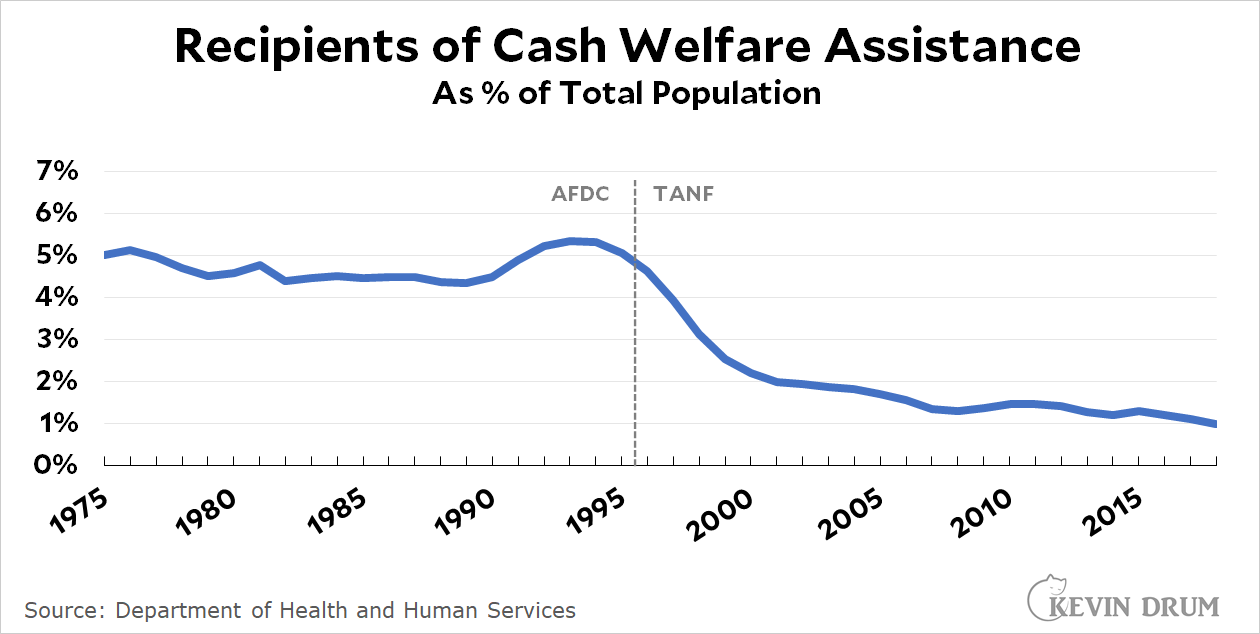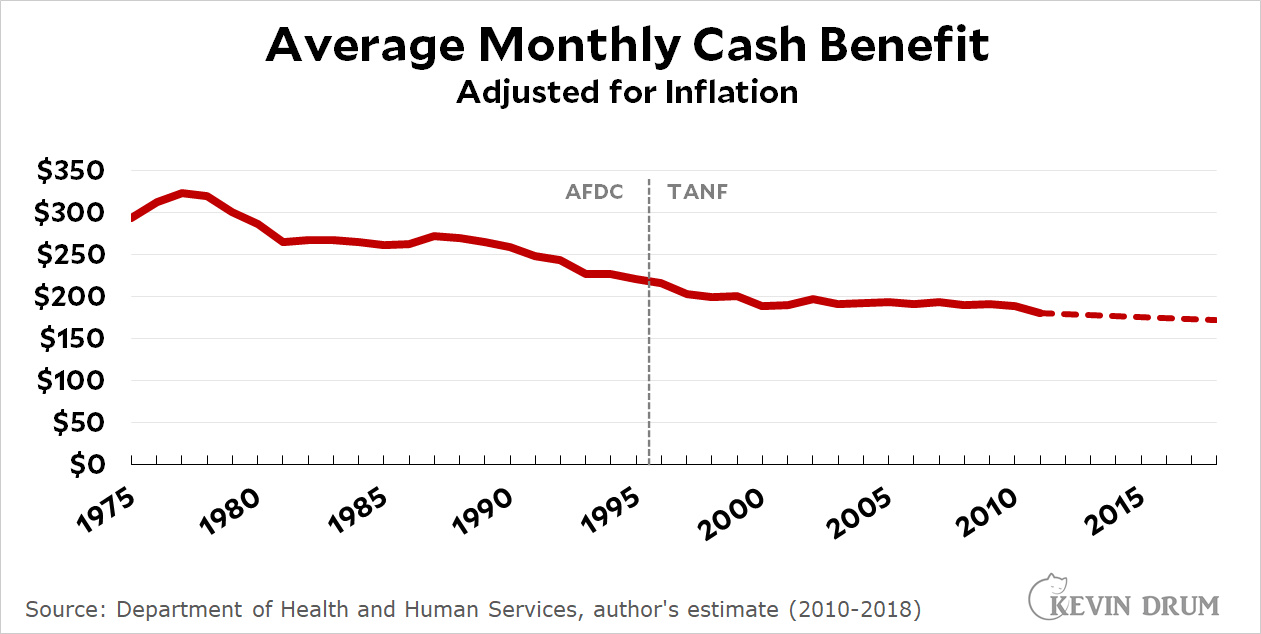The first federal program to give cash to poor people was called Aid to Families with Dependent Children (AFDC), passed in 1935 as part of the New Deal. It was aimed at widows with children, a group that, at the time, everyone agreed should be supported with cash specifically so they didn't have to work and could instead devote time to raising their families.
In the '60s AFDC was steadily expanded to include anyone with children, which made the program increasingly unpopular. Widows during the Great Depression were one thing, but single mothers without jobs during good economic times were quite another—especially because so many of them were now urban and Black. In the '90s, the AFDC rolls started to increase, reaching a high point of 14 million recipients, and public support for cash payments designed to allow women not to work floundered. As a result of all this, Bill Clinton promised during the 1992 presidential campaign to "end welfare as we know it."
In 1995 AFDC was abolished and replaced with Temporary Assistance for Needy Families (TANF). Its emphasis was on work, and it put limits on how long unemployed mothers could receive assistance. As a result, the TANF rolls fell dramatically:

The average benefit from AFDC slowly dropped in the '70s and '80s, and that decline continued after the switch to TANF:

Today, the TANF rolls have dropped to about 3 million people and monthly checks average about $170. For practical purposes, cash welfare has been all but eliminated.
Data comes from the Department of Health and Human Services. Total recipients are here (Appendix A, TANF Table 1) and here (Table 7 Indicator 3). Average benefits are here through 2011 and extrapolated from CBPP estimate of average 2010-2020 decrease here (Appendix Table 3) for 2012-2018.

Michelle Goldberg sums it up:
"There are several reasons our domestic policy has long been uniquely hostile to parents, but two big ones are racism and religious fundamentalism. Essentially, it’s been politically radioactive for the federal government to support Black women who want to stay home with their kids, and white women who want to work."
LOL. Parent(s).
"but single mothers without jobs during good economic times were quite another—especially because so many of them were now Black."
That's pretty much American welfare policy over the past century in a nutshell -- programs to help poor people start off popular with broad support, but as soon as it's perceived too many non-white people are taking advantage of them, it's outrageous socialism and must be stopped. New Deal programs were hugely popular, even in very conservative, rural areas, but as soon as Johnson's Great Society program opened them up to Blacks, it was only a matter of time before we got Reagan and his young bucks in Cadillacs stocking up on steak using food stamps.
Only about 25% of the TANF budget goes directly to recipients. It is a block grant (slush fund) for most states. https://www.cbpp.org/research/family-income-support/temporary-assistance-for-needy-families
Maximus, Inc., needs to fund its end of year parties somehow.
Something isn’t adding up. I was never on welfare and I was just a kid in the 70s, but the things I heard and read in the 70s, 80s, and since makes me think something is wrong about the payments you show for the past. I think they were more. I even called a friend and he agreed that those numbers must be off.
Krugman wrote something defending the recent child tax deduction by saying something like: Giving everyone this amount of money without a work requirement is reminiscent of welfare payments before they changed the system, but it is different in a significant way. The amount of money back then was just enough to live on, even if it meant a very low standard of living. No one today can live on the $300 a month of this new deduction.
I don’t remember Krugman’s exact words, but that is basically what he said. In any case, I’m sure the amount back then was not 300 INFLATION ADJUSTED dollars per month. No one could live on that. Even in rural areas, let alone urban ones.
Wait a minute… are those weekly amounts. I could believe that.
Well, as long you and a friend think the numbers are wrong, then they must be wrong. Kevin sourced all his numbers. Here’s another source I found in 5 seconds of Googling that claims the average *monthly* welfare payment in the DC area in 1978 was $230 unadjusted for inflation since the article was written in 1980. That puts Kevin’s adjusted for inflation charts in the right ballpark. Where’s your charts of your childhood memories of what welfare payments were?
https://www.washingtonpost.com/archive/local/1980/06/22/welfare-families-said-hard-hit-in-70s/95390c9e-0b4f-44d7-b6c8-95dfc2ea82a0/
OK, I had to laugh at your reply. You give a number indicating that Kevin's number is wrong and that I am right. While at the same time you present it it in a condescending way to demonstrate how wrong you think I am. Quite a debater.
If you honestly think $230 a month in 1978 is the equivalent to around $300 a month in todays dollars then there isn't much to discuss with you. Keep those deep thoughts coming.
OK, I came back a 3rd time and I think I understand what Kevin meant, finally. The chart shows payments in constant 1975 dollars. Not in 2021 dollars.
So I'm the fool. Well, sort of. In my defense Kevin does say this: "Today, the TANF rolls have dropped to about 3 million people and monthly checks average about $170." So Kevin misread his own chart. Unless I misunderstood again, he means that the size of the monthly check sent out today are the equivalent of a $170 check sent out in 1975.
Part of your confusion might be that your memories include other non-cash payments to the family. The average family on AFDC used to get $300ish of cash plus food stamps plus housing assistance plus the refundable EITC plus possibly other benefits (Medicaid, utility subsidies, etc.). The *combination of all those programs* may have allowed them to survive without working. But none of those programs handed out actual cash to the family, except for the $300ish AFDC check and the once a year EITC payment.
I do understand that some articles and descriptions of families living on welfare included other programs. Certainly many of the more recent ones do, but again, my impression from reading and listening to people that report on this, is that the cash people were getting in the 70s was more than what Kevin found.
I also get the impression that programs like section 8 housing and other such programs reach significantly more people today than they did in the 70s. I could be wrong and almost everyone on welfare in the 70s belonged to long list of programs and when reading/listening to their stories the reporter didn't differentiate between programs. I still get them impression that the cash portion was greater than Kevin indicates.
Before I posted I did do a quick search on what monthly welfare benefits are today so I wouldn't be completely off base. I only spent a few minutes and the sources didn't list every state. Places like Alabama did show a monthly average around $170, but most of the other states had much higher monthly numbers. Maybe if I really cared I'd do a more thorough search, but Kevin's numbers just don't seem correct.
Oh, I didn't realize you posted twice and are the same guy I made fun of above. This post is much more intelligent, but I don't take back making fun of your other post because you listed $230 a month in unadjusted 1978 dollars as disproving my point when it was exactly the thing I was talking about. EXACTLY!
I don't mind being challenged. I get things wrong all the time, but you made a post that provided evidence I was right. That my memories and impressions were correct.
I do understand that memories and impressions can be wrong and that is why we have the scientific method, but it isn't like I live in my Mom's basement and get all my facts form Rush's dead body. News people write and talk about things. The friend I talked to sometimes will mix up his impressions of today with impressions he had when he was young, but it doesn't change the fact that to both of us, Kevin's numbers do not seem correct.
Why should white folks subsidize non-white reproduction?